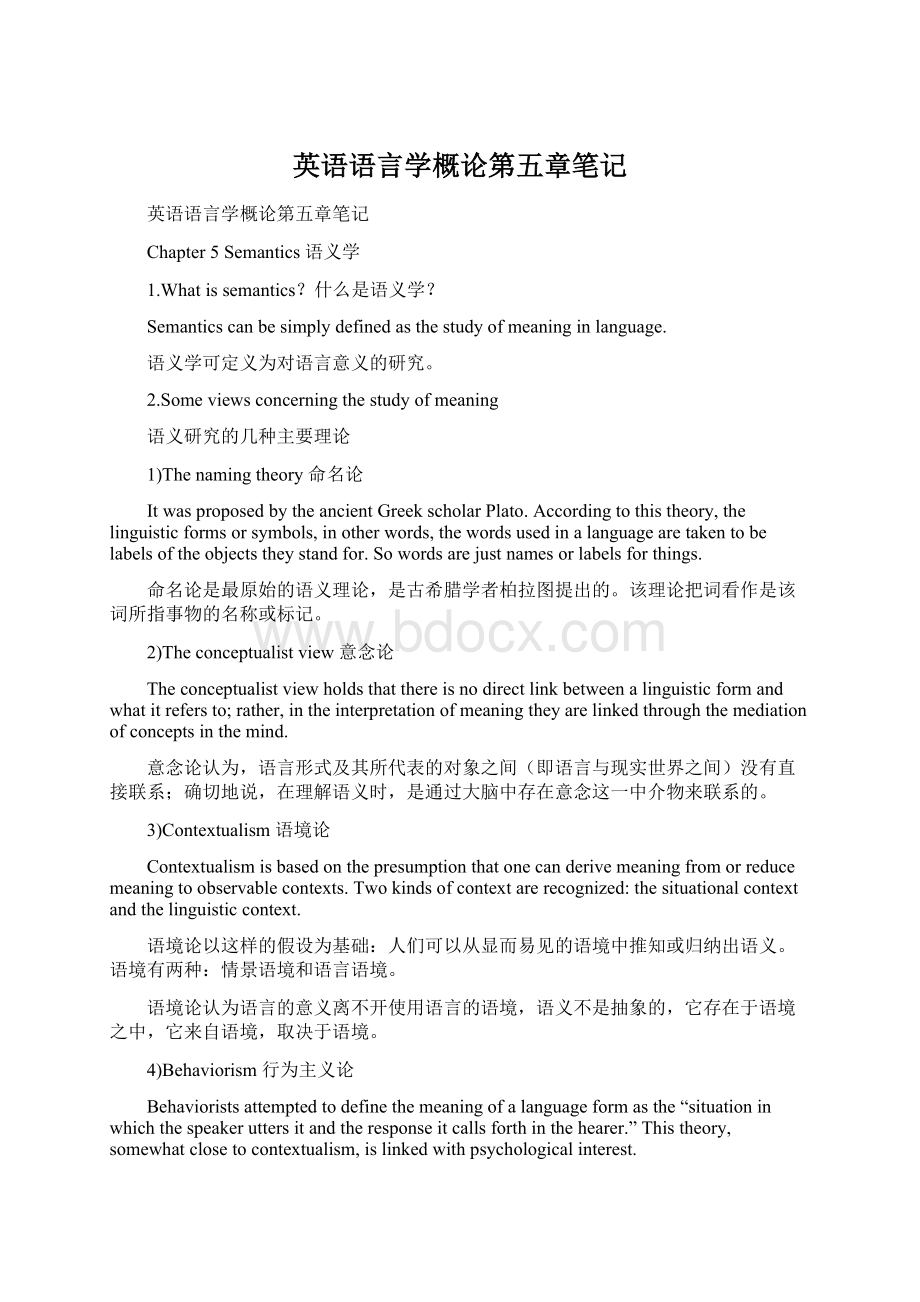英语语言学概论第五章笔记.docx
《英语语言学概论第五章笔记.docx》由会员分享,可在线阅读,更多相关《英语语言学概论第五章笔记.docx(9页珍藏版)》请在冰豆网上搜索。

英语语言学概论第五章笔记
英语语言学概论第五章笔记
Chapter5Semantics语义学
1.Whatissemantics?
什么是语义学?
Semanticscanbesimplydefinedasthestudyofmeaninginlanguage.
语义学可定义为对语言意义的研究。
2.Someviewsconcerningthestudyofmeaning
语义研究的几种主要理论
1)Thenamingtheory命名论
ItwasproposedbytheancientGreekscholarPlato.Accordingtothistheory,thelinguisticformsorsymbols,inotherwords,thewordsusedinalanguagearetakentobelabelsoftheobjectstheystandfor.Sowordsarejustnamesorlabelsforthings.
命名论是最原始的语义理论,是古希腊学者柏拉图提出的。
该理论把词看作是该词所指事物的名称或标记。
2)Theconceptualistview意念论
Theconceptualistviewholdsthatthereisnodirectlinkbetweenalinguisticformandwhatitrefersto;rather,intheinterpretationofmeaningtheyarelinkedthroughthemediationofconceptsinthemind.
意念论认为,语言形式及其所代表的对象之间(即语言与现实世界之间)没有直接联系;确切地说,在理解语义时,是通过大脑中存在意念这一中介物来联系的。
3)Contextualism语境论
Contextualismisbasedonthepresumptionthatonecanderivemeaningfromorreducemeaningtoobservablecontexts.Twokindsofcontextarerecognized:
thesituationalcontextandthelinguisticcontext.
语境论以这样的假设为基础:
人们可以从显而易见的语境中推知或归纳出语义。
语境有两种:
情景语境和语言语境。
语境论认为语言的意义离不开使用语言的语境,语义不是抽象的,它存在于语境之中,它来自语境,取决于语境。
4)Behaviorism行为主义论
Behavioristsattemptedtodefinethemeaningofalanguageformasthe“situationinwhichthespeakeruttersitandtheresponseitcallsforthinthehearer.”Thistheory,somewhatclosetocontextualism,islinkedwithpsychologicalinterest.
语义的行为主义论和语义的语境论有相似之处,它也把语义放到语境中去研究,但它更注重人的心理活动,认为语言的意义存在于语言使用者在交际过程中对听到话语的反应。
3.Senseandreference意义和所指
Theyaretworelatedbutdifferentaspectsofmeaning.
它们是词汇意义的既相互联系又有所不同的两个方面。
1)Senseisconcernedwiththeinherentmeaningofthelinguisticform.Itisthecollectionofallthefeaturesofthelinguisticform;itisabstractandde-contextualized.Itistheaspectofmeaningdictionarycompliersareinterestedin.
意义关心的是语言形式的内在意义。
它是语言形式所有特征的总和,它是抽象且脱离语境的。
它是词典编写者们所感兴趣的语义方面。
简单地说,意义是词汇内在的,抽象的,游离于语境之外的意义。
2)Referencemeanswhatalinguisticformreferstointhereal,physicalworld;itdealswiththerelationshipbetweenthelinguisticelementandnon-linguisticworldofexperience.
所指是语言形式在现实世界中所指称的东西;涉
department
Windscreenwindshield
Torchflashlight
a)Stylisticsynonyms–synonymsdifferinginstyle.
Wordshavingthesamemeaningmaydifferinstyle,ordegreeofformality.Inotherwords,somewordstendtobemoreformal,otherscasual,andstillothersneutralinstyle.
文体同义词-在文体上有差异的同义词。
有同样意义的词可能在文体上,或者在正式程度上有所不同。
也就是说,有些往往比较正式,有些比较随意,有些在问题上则是中性的。
示例:
Oldman,daddy,dad,father,maleparent
Start,begin,commence
Kid,child,offspring
b)Synonymsthatdifferintheiremotiveorevaluativemeaning
Therearewordsthatbearthesamemeaningbutexpressdifferentemotionsoftheuser,indicatingtheattitudeorbiasoftheusertowardwhatheistalkingabout.
情感意义或评价意义有所不同的同义词。
有着相同的意义却表达了使用者的不同情感的词语,这些词暗示使用者对他所谈论的事情的态度或倾向。
示例:
Collaborator合作者/Accomplice同谋者,帮凶
Like,love,admire,adore,worship
Economical,frugal,thrifty,mean,miserly,stingy
c)Collocationalsynonyms–synonymsdifferingintheircollocation.
Somesynonymsdifferintheircollocation,i.e.,inthewordstheygotogetherwith.Thisisamatterofusage.
搭配同义词-同义词在其搭配上各不相同,即能和这些不同的同义词相配的词各不相同。
示例:
Accuse…ofcharge…withrebuke…for
d)Semanticallydifferentsynonyms–synonymsthatdifferslightlyinwhattheymean.
语义上不同的同义词-同义词的意义非常接近,但却有细微差别。
示例:
Amaze暗示困惑和迷惑astound暗示难以置信
Escape意味逃离不愉快或者危险的事flee意味匆匆离开
1)Polysemy多义关系
Thesameonewordmayhavemorethanonemeaning.Thisiswhatwecallpolysemy,andsuchawordiscalledapolysemicword.Thefactisthemorecommonlyusedawordis,themorelikelyithasacquiredmorethanonemeaning.
同一个单词可能有一个以上的意义,这就是我们所说的一词多义,这样的词叫多义词。
一个词越常用,它就越可能获得一个以上的意义。
示例:
Table一词最初只有一个意义,很可能指一块石板或木板,这叫做其原始意义。
后来它逐渐获得了它现在所指称的其它意义。
2)Homonymy同音/同形异义关系
Homonymyreferstothephenomenonthatwordhavingdifferentmeaninghavethesameform,i.e.,differentwordsareidenticalinsoundorspelling,orinboth.
Whentwowordsareidenticalinsound,theyarehomophones.
Whentwowordsareidenticalinspelling,theyarehomographs.
Whentwowordsareidenticalinbothsoundandspelling,theyarecompletehomonyms.
同形异义是指意义不同的词有着相同的语言形式的现象,即不同的词发音上或拼写上,或者两个方面都相同。
两个单词在发音上相同时,叫同音异义词。
两个单词在拼写上相同时,叫同形异义词。
两个单词在发音和拼写上都相同时,叫完全同形异义词。
示例:
同音异义词:
rain/reign;night/knight;piece/peace
同形异义词:
bowv./bown.;tearv./tearn.;leadv./leadn.
完全同形异义词:
fastadj./fastv.;scalen./scalev.
3)Hyponymy上下义关系
Hyponymyreferstothesenserelationbetweenamoregeneralmoreinclusivewordandamorespecificword.Thewordwhichismoregeneralinmeaningiscalledthesuper-ordinate,andthemorespecificwordsarecalleditshyponyms.Hyponymsofthesamesuper-ordinateareco-hyponymstoeachother.
上下义关系是指一个具有一般性、包容性的词与一个更为具体的词之间的意义关系。
意义更具有一般性的词叫上义词,意义更为具体的词叫下义词。
同一个上义词的多个下义词叫并列下义词。
示例:
上义词:
flower
下义词:
rose(玫瑰花),tulip(郁金香),carnation(康乃馨),lily(百合花),morningglory(牵牛花)
上义词:
animal
下义词:
dog,cat,tiger,lion,wolf,elephant,fax,bear
4)Antonymy反义关系
Thetermantonymyisusedforoppositenessofmeaning,wordsthatareoppositeinmeaningareantonyms.
反义关系用以指意义的相反。
意义上相反的词叫反义词。
a)Gradableantonyms分级反义词
Someantonymsaregradablebecausethereareoftenintermediateformsbetweenthetwomembersofapair.Soitisamatterofdegree.
一些反义词是级别上的对立,因为一对这样的反义词中间常有其它表示程度的词。
意义相反实际上只是程度问题。
示例:
Old和young是反义词,但它们代表两个极端,中间还存在着代表年老和年轻的不同程度的其它语言形式,如middle-aged,mature,elderly.
b)Complementaryantonyms互补反义词
Apairofcomplementaryantonymsischaracterizedbythefeaturethatthedenialofonememberofthepairimpliestheassertionoftheother.
互补反义词具有这样的特征,否定其中一个就意味着肯定另一个。
也就是说,是一个非此即彼、非彼即此的问题。
示例:
Male/femalealive/dead
c)Relationalopposites关系反义词
Pairsofwordsthatexhibitthereversalofarelationshipbetweenthetwoitemsarecalledrelationalopposites.
在意义上现实出逆向关系的一对词语叫关系反义词。
示例:
Wife/husbandfather/sonteacher/pupildoctor/patientbuy/sellabove/below
4.Senserelationsbetweensentences
句子间的意义关系
1)XissynonymouswithY.
X和Y是同义关系
示例:
X:
Heisabachelorallhislife.
Y:
Henevermarriedallhislife.
如果X是真的,Y也是真的,如果X是假的,Y也是假的。
2)XisinconsistentwithY.
X和Y是前后矛盾关系
示例:
X:
Johnismarried.
Y:
Johnisabachelor.
如果X是真的,Y就是假的,如果X是假的,Y就是真的。
3)XentailsY(YisanentailmentofX)
X蕴涵Y(Y是X的蕴涵)
示例:
X:
Johnmarriedablondheiress(女继承人).
Y:
Johnmarriedablond.
蕴涵是一种包含关系。
如果X蕴涵Y,X的意义就为Y所包含。
4)XpresupposesY.(YisaprerequisiteofX)
X预示Y(Y是X的先决条件)
示例:
X:
John’sbikeneedsrepairing.
Y:
Johnhasabike.
5)Xisacontradiction.
X是个矛盾句
示例:
X:
Myunmarriedsisterismarriedtobachelor.
X句子本身自相矛盾,它永远是假的。
6)Xissemanticallyanomalous.
句子X在语义上反常
示例:
X:
Thetablehasbadintentions.
X在语义上反常,它就是荒唐的。
5.Analysisofmeaning
1)Componentialanalysis–awaytoanalyzelexicalmeaning
语义成分分析法-一种词义分析法
Theapproachisbaseduponthebeliefthatthemeaningofawordcanbedissectedintomeaningcomponents,calledsemanticfeatures.Plusandminussignsareusedtoindicatewhetheracertainsemanticfeatureispresentorabsentinthemeaningofaword,andthesefeaturesymbolsareusuallywrittenincapitalizedletters.
一个单词的意义可以分析为被称作语义特征的意义成分。
用加减号来表示某一语义特征在一个词义中是存在还是省缺,这些特征符号通常用大写字母来表示。
Oneadvantageofcomponentialanalysisisthatbyspecifyingthesemanticfeaturesofcertainwords,itwillbepossibletoshowhowthesewordsarerelatedinmeaning.
成分分析的一个好处是,通过列出某些单词的语义特征,就可能显示这些单词在意义上有什么联系。
示例:
Man和woman这两个单词有+HUMAN,+ADULT,+ANIMATE这些共同的特征,但在MALE这一特征上不同。
Man和boy这两个单词有+HUMAN,+ANIMATE,+MALE这些共同的特征,但在ADULT这一特征上不同。
2)Predicationanalysis–awaytoanalyzesentencemeaning
述谓结构分析-一种句义分析法
Linguistshaveproposeddifferentwaystoanalyzethemeaningofsentences.Theymightdifferintheirframeworkofanalysis,buttheysharetheaimtoabstractthemeaningofsentences.WhatwearegoingtointroducebrieflyisthepredicationanalysisproposedbythelinguistGLeech.
语言学家们提出了不同的分析句子意义的方法。
他们的分析基准体系可能有所不同,但他们的目标都是使句子意义抽象化。
我们现在要介绍的是英国语言学家G里奇提出的述谓结构分析法。
Ingrammaticalanalysis,thesentenceistakentobethebasicunit,anditisanalyzedintosuchgrammaticalcomponentsassubject,predicate,andattribute.
对句子进行语法分析时,句子被视为基本单位,它被分析谓诸如主谓语和定语这样的语法成分。
Insemanticanalysisofasentence,thebasicunitiscalledpredication,whichistheabstractionofthemeaningofasentence.Thisappliestoallformsofsentence,includingstatements,imperativeandinterrogativeforms.
对句子进行意义分析时,基本单位称为述谓,这是对句子意义的抽象化。
这一方法适用于所有句式,包括陈述句、祈使句和疑问句。
Apredicationconsistsofargument(s)andpredicate.
Anargumentisalogicalparticipantinapredication,largelyidenticalwiththenominalelement(s)inasentence.
Apredicateissomethingsaidaboutanargumentoritstatesthelogicalrelationlinkingtheargumentsnasentence.
一个述谓由一个或数个论元和一个谓词组成。
一个论元是一个述谓的一个逻辑参与者,与一个句子中的一个或数个名词性成分大体一致。
一个谓词是关于论元的陈述,或者说明一个句子的论元间的逻辑关系。
句子的语法形式不影响其语义述谓,下列所有句子具有同样的述谓:
Tomsmokes.
Tomissmoking.
Tomhasbeensmoking.
Tom,smoke!
DoesTomsmoke?
这是同一语义述谓TOM(SMOKE)在语法上的多种体现。
Accordingtothenumberofargumentscontainedinapredication,weclassifythepredicationsintotwo-placepredication(containingtwoarguments),one-placepredication(containingoneargument),andno-placepredication(containingnoargument).
根据一个述谓中所包含的论元的数目,我们把述谓结构分为两位述谓结构(包含两个论元)、单位述谓结构(包含一个论元)和零位述谓结构(没有论元)
示例:
Thebuildingisnexttothelibrary.(Two-placepredication)
Heissnoring.(One-placepredication)
Itislate.(No-placepredication)